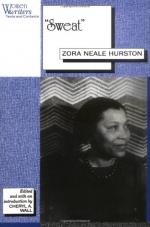|
This section contains 220 words (approx. 1 page at 400 words per page) |

|
Sweat Summary & Study Guide Description
Sweat Summary & Study Guide includes comprehensive information and analysis to help you understand the book. This study guide contains the following sections:
This detailed literature summary also contains Bibliography on Sweat by Zora Neale Hurston.
In 1926, a group of writers from the younger generation of the "New Negro" movement inNew York City, including Langston Hughes and Zora Neale Hurston, decided to organize the quarterly magazine Fire!! Frustrated by the responsibilities thrust on them by Alain Locke and other leaders of the Harlem Renaissance, these writers wanted to express their own ideas without the artistic constraints of a political agenda. And, although they only managed to publish one issue because of a host of complications, the magazine left behind one of the most lasting legacies of the radical younger generation of black writers, still considered Hurston's best fiction of the period: a short story titled "Sweat."
Now available in the complete collection of Hurston's stories published by HarperCollins (1995), "Sweat" focuses on the turning point in the life of Delia Jones, a washerwoman from Hurston's hometown ofEatonville, Florida. Beginning with an outburst against her abusive husband and finishing with her involvement in his death, the story follows Delia through a transformation, an upheaval of values that Hurston is interested in setting in the context of the Harlem Renaissance inNew York City. The author makes use of biblical allusion and African American folk culture to attack issues of gender and oppression that were taboo topics at the time and continue to have a wide significance today.
Read more from the Study Guide
|
This section contains 220 words (approx. 1 page at 400 words per page) |

|



